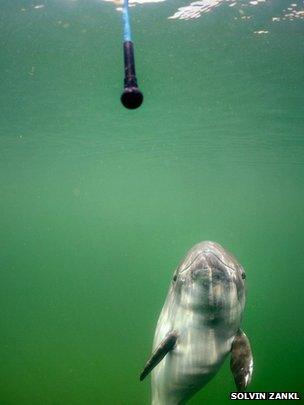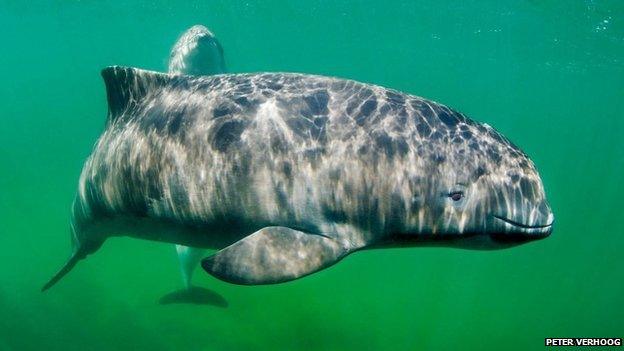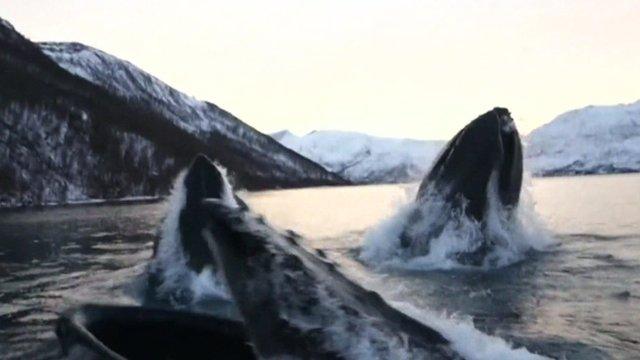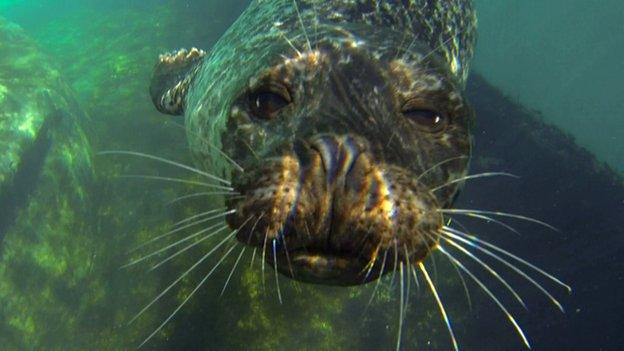Porpoises, whales and dolphins use 'sound searchlights'
- Published
The researchers fitted porpoises with acoustic tags, recording and measuring sound as the animals approached targets
Researchers in Denmark have revealed how porpoises finely adjust the beams of sound they use to hunt.
The animals hunt with clicks and buzzes - detecting the echoes from their prey.
This study showed them switching from a narrow to a wide beam of sound - "like adjusting a flashlight" - as they homed in on a fish.
Researchers think that other whales and dolphins may use the same technique to trap a fish in their beam of sound in the final phase of an attack.
This could help prevent porpoises, whales and dolphins' prey from evading their capture.
By revealing these acoustic secrets in detail, researchers are hoping to develop ways to prevent porpoises, and other toothed whales, from becoming trapped in fishing nets.
The study, published in the journal eLife, external, was led by Danuta Wisniewska of Aarhus University.
She and her colleagues worked with harbour porpoises in a semi-natural enclosure at a conservation research centre on the coast of Denmark, external.

The scientists used underwater microphones to measure sounds that the porpoises produced
"The facility is quite exceptional, " explained Dr Wisniewska. "The animals still have access to the seafloor and are only separated from the harbour by a net. Fish are able to come in, so they're still hunting."
In this unique environment, the researchers were able to fit the porpoises with sound-detecting tags, and to place an array of microphones to pick up sound around their enclosure.
The team carried out a series of these experiments to work out where the sound energy the porpoises produced was being directed
In one experiment, researchers dropped fish into the water to tempt the porpoises to hunt.
As echolocating porpoises, whales and dolphins hunt, they switch from an exploratory clicking to a more intense, high frequency buzz - to elicit a continuous echo from the fish they are pursuing.
Their beam can be envisaged a cone of sound, said Dr Wisniewska, comparing it to the cone-shaped beam of light from a torch.

Underwater hunters

•Toothed whales and dolphins, collectively known as odontocetes, use echolocation to hunt and navigate
•Echolocating clicks pass through a fatty structure at the front of their skull called the melon. It is this structure that forms a visible bulge on the animal's head and researchers say it acts as an adjustable acoustic lens, focusing the sound into a beam and altering the size of that beam
•Other non-echolocating marine mammals have different tricks for finding their way underwater. Seals, for example, have super-sensitive whiskers, which can detect the fattest fish by sensing the trail they leave behind, external

"If you were trying to find your car in a car park, you could use a narrow beam over a long distance and still see a lot," she explained.
"But when you're trying to get your keys into the car, you would switch to a wider beam.
"This is similar to what we see in porpoises."
According to this study, the porpoises were able to broaden their beam by as much as 50% in the final phase of their attack. And they were able to switch between a narrow and a wide beam.
This fine-tuning ability is controlled by a fatty structure in their forehead, called the melon, which acts as a sort of "sound lens".
Sound the alarm
The harbour porpoises involved in this study came to the harbourside facility having been rescued after being caught in fishing nets. And the researchers hope this work will help develop ways of using sound to prevent porpoises from accidentally chasing fish into these nets.

Harbour porpoises, like other whales and dolphins, hunt using sound
"My research suggests that they really attend to their target, so we could be seeing a sort of attention blindness," said Dr Wisniewska, explaining that porpoises might be so intently focused on the one fish they are hunting that they ignore their surroundings while they pursue it into a net.
Sufficiently loud and repetitive underwater sounds - emitted from fisheries - could help alert porpoises, whales and dolphins to the presence of a fishing net, and help keep them away.
- Published15 November 2014

- Published14 June 2013
